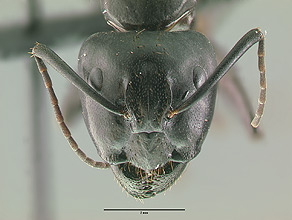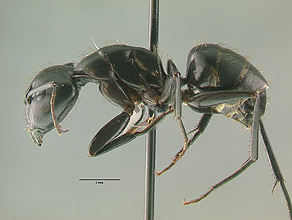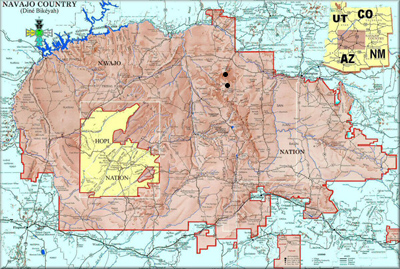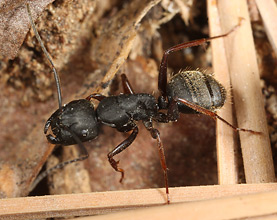- Identification
- The majors, minors, and females of this polymorphic species are predominantly dull black or dark brown ants. The legs, and portions of the head and the mesonotum, may show some dark red coloration. The gaster has golden appressed hairs with at least a few of these overlapping adjacent hairs. These hairs tend to be half the size of the erect hairs found on the gaster. Other parts of the body also have some appressed golden hairs but these are not nearly as dense as what is found on the gaster. Erect hairs are found on the apex of the scape, scattered along the dorsum of the mesonotum, along the borders of the clypeus and on the top of the petiole. The cheeks and sides of the head are without erect hairs (Mackay).
- Biology
- Gregg (1950) notes in Colorado: "Camponotus modoc has a predilection for rotting logs and stumps in practically all stages of decay, and consistent with this preference it is almost never found outside of forested or wooded habitats. An exception may be when wood of suitable size and condition is found in an open habitat. This ant ... would appear to prefer relatively warm climates, but the fact that it can penetrate high, cold areas implies considerable tolerance to low temperatures."
- additional biology notes...
- Distribution
- Range
- Canada, United States, Mexico. Alaska, western Canada (Yukon Territory) and United States, south to Chihuahua and Nuevo León. México. There are a few records of this species occurring in New Hampshire. You can find a range map for this species at the North American Database of Ant Species.
- Navajo Reservation Records
- Records being processed.
- Additional Notes
- Habitat and Nesting
- Camponotus modoc is a montane species that is typically found at higher elevations in mountainous regions. Elevation, not forest type, appears to determine where it can be found. This species will inhabit hardwood, pine and mixed forests provided there are good nesting locations - large blocks of dead wood such as stumps, downed boles or dead standing trees. Nests can be spread over a number of locations, with one main nest and one or more satellite nests. On occasion a colony may be found living outside of their preferred habitat and/or not nesting in wood. This species will also nest in houses and other man made wooden structures..
- Foraging
- (summarized from Hansen and Akre 1985): Colonies are large, perhaps obtaining a size of 50,000 individuals. Foraging takes place from spring through early fall. Foraging trails are used to move between the nest and foraging areas. Individual trails are used for varying amounts of time, from part of a season to multiple years. Protected subterranean trails and semi-protected trails that follow the edges of objects (roots, patio blocks, etc.) may become incorporated into actively used trails. Activity outside the nest can occur throughout the day or night and from the spring to the early fall but foraging, as defined by the number of individuals exiting the nest, is heaviest at night.
- Liquid resources are transported in the crop, which can become quite distended. When full the gaster expands and exposes the integument connecting the tergites and sternites. The difference in the shape and size of the gaster between an returning engorged forager and a forager just leaving the nest can be quite remarkable. Liquid resources may be obtained from tending Homopterans or from other sources. Dead insects and other food items are also carried back to the nest, although only a small percentage of foragers return with non-liquid food resources. Group retrieval is not common and, when it does occur, usually is limited to a small number of foragers.
- Mating Flights
- Spring mating flights can occur simultaneously across large areas and yield huge numbers of sexuals. Mating swarms have also been observed during the summer months. Queens can be quite noticeable after mating flights. Large dealates females can be found walking on and around wooden structures, looking for a location to start a new colony. The stores of nutrients contained within these corpulent queens are a boon to small animals that can opportunistically find and feed upon these reproductives.
- Early Colony Growth
- Laboratory cultures of nascent queens from Washington state (Hansen and Akre 1985) showed the following: eggs were produced soon after dealate queens were collected from a mating flight (spring). Eggs began to hatch two to five weeks after the first were produced. More than half of these eggs were used for food. Pupae developed after three to seven weeks with a peak in number during July. The first workers emerged after seven to ten weeks. In August or September queens stopped laying eggs and new development, in general, ceased. No pupae were present at this time and both the larvae and the queen went through an overwintering diapause. In the first year, new colonies produced from 2 to 10 workers. Egg laying resumed in late January or late February, and ceased sometime from July through September. Egg laying was predominately confined to two pulses; the initial pulse initiated with the production of the first eggs of the season and another pulse later in the year.
- Etymology
- Geographic. The Modoc were a tribe of Native Americans that inhabited southwestern Oregon and northeastern California. The species name presumably reflects upon the region where the type specimens were collected.


- Literature
- Forel, A. 1879. Études myrmécologiques en 1879 (deuxième partie [1re partie en 1878]). Bulletin de la Société Vaudoise des Sciences Naturelles. 16:53-128. PDF
- Gregg, R. E. 1963. The ants of Colorado, with reference to their ecology, taxonomy, and geographic distribution. University of Colorado Press, Boulder.
- Hansen, L. D. and R. D. Akre. 1985. Biology of carpenter ants in Washington State (Hymenoptera: Formicidae: Camponotus). Melanderia. 43:1-62.
- Wheeler, W. M. 1910. The North American ants of the genus Camponotus Mayr. Annals of the New York Academy of Sciences. 20:295-354. PDF
- A note about these publications. The literature cited here is not meant to be an exhaustive list of papers published about this species.
Page authored by David Lubertazzi and Gary Alpert



